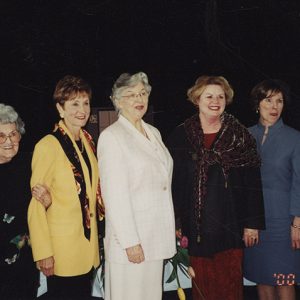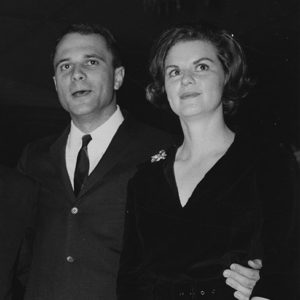calsfoundation@cals.org
Barbara Jean Lunsford Pryor (1938–)
Barbara Pryor is an Arkansas filmmaker, businesswoman, and arts advocate. As the wife of David Pryor, she was Arkansas’s thirty-ninth first lady. Outside of politics, she has been best known for her work as a film producer, in the arts, and for the David and Barbara Pryor Center for Arkansas Oral and Visual History at the University of Arkansas (UA) in Fayetteville (Washington County).
Born on December 26, 1938, in Fayetteville, Barbara Jean Lunsford was the only daughter of five children born to Bruce and RosaLee Lunsford. The Lunsfords were antique dealers in Fayetteville. After graduating from Fayetteville High School in 1956, she enrolled at UA. In her freshman year, Lunsford met an upperclassman from Camden (Ouachita County) named David Pryor, who was heavily involved in student government and in a number of other leadership roles at the university. A whirlwind courtship led to their marriage in November 1957, and she left the university without earning a degree. They moved to David Pryor’s hometown of Camden after he graduated.
The Pryors had three sons: David Jr., Scott, and Mark. In Camden, Pryor worked with her husband in establishing and running the weekly newspaper the Ouachita Citizen. After the birth of her first son—which was announced in a headline in the Citizen with the news, “It’s a Man!”—she cut back on her newspaper work. In 1962, her husband was elected to the Arkansas House of Representatives and entered the University of Arkansas School of Law in Fayetteville after the newspaper went out of business.
When David Pryor was elected to the U.S. House of Representatives in 1966 from Arkansas’s Fourth District, the family relocated to Washington DC. During her six years there, from 1967 to 1973, she was active in the congressional spouses’ organizations and in the activities of their three young sons. Spending much time commuting between Washington and Camden during this period, the Pryors purchased a home in Little Rock (Pulaski County) when David ran unsuccessfully for the U.S. Senate in 1972. The home for a time became the hub of Pryor campaign activity. The same was true during her husband’s successful bid for governor in 1974. Shortly after David Pryor’s inauguration in January 1975, Barbara Pryor found that the demands of her new role had overwhelmed her, and in March, she was hospitalized for exhaustion. After leaving the hospital, she retired to the family’s lake home on Lake Hamilton near Hot Springs (Garland County), where she remained until November 1976.
During this time of rest and recovery, she developed her own interests and identity. Taking courses in the Arts and Sciences Department at the University of Arkansas at Little Rock, she soon became involved in the making of a movie being filmed in Texarkana (Miller County), The Town That Dreaded Sundown. The producer, Charles Pierce, had once worked on the Pryors’ newspaper. First hired as an assistant wardrobe mistress, Pryor would become an assistant script supervisor, allowing her to learn the details of production. She ended up raising $1 million from twelve investors and became the executive producer of a movie titled Wishbone Cutter, which was filmed entirely in the Buffalo River area. The film starred Sondra Locke and Slim Pickens.
At the Governor’s Mansion, Pryor closely supervised redecorating efforts, served on the board of Goodwill Industries, and worked for the benefit of the Arkansas Repertory Theatre, Arkansas Children’s Hospital, the Arkansas Arts Center (now the Arkansas Museum of Fine Arts), and Volunteers in Little Rock Public Schools. She also was one of the original members of the Committee of One Hundred, which was formed for the support of the Ozark Folk Center, which was brought into the state parks system under her husband’s administration. During her husband’s years in the U.S. Senate, she ran an interior design business; negotiated the sale of the rights to Wishbone Cutter to CBS; served as co-chair of the annual PEN/Faulkner Awards, a program that honored outstanding young fiction writers; and established the first U.S. Senate exhibit and reception that exclusively honored Arkansas artists. She also collaborated with Anne McMath in the production of the book First Ladies of Arkansas: Women of Their Times and served on the Honorary Board of Directors of the Governor’s Mansion Commission.
After four years in the executive mansion and eighteen years in Washington while David Pryor served in the U.S. Senate, the Pryors returned home to Arkansas. In 2013, the Pryors received the Pat and Willard Walker Tribute Award at the University of Arkansas for Medical Sciences Winthrop P. Rockefeller Cancer Institute Gala for Life, in recognition of their work on behalf of the institute. Following in the footsteps of his father, the Pryors’ son Mark served two terms in the U.S. Senate as a Democrat before he was defeated for reelection in 2014.
One of the couple’s proudest achievements in retirement was the establishment in 1999 of the David and Barbara Pryor Center for Arkansas Oral and Visual History at UA, with a mission to “document the cultural heritage of Arkansans by collecting audio and video resources to share with scholars, students, and the public.” This was an extension of the couple’s longstanding interest in historic preservation and Barbara Pryor’s interest and experience in film.
For additional information:
Kotz, Mary Lynn. “Governor and Mrs. David Pryor of Arkansas: How Her Job Saved Their Marriage.” Publication from 1977. David Pryor Collection. Special Collections. University of Arkansas Libraries, Fayetteville, Arkansas.
Maack, Jo Ellen. Undated interview with Barbara Pryor. Old State House Museum, Little Rock, Arkansas.
Mann, Judy. “Barbara Pryor Is Back as a Complete Person.” Washington Post, March 16, 1979.
McMath, Anne. First Ladies of Arkansas: Women of Their Times. Little Rock: August House, 1989.
Revis Edmonds
Old State House Museum
 Arts, Culture, and Entertainment
Arts, Culture, and Entertainment Divergent Prosperity and the Arc of Reform, 1968–2022
Divergent Prosperity and the Arc of Reform, 1968–2022 Politics and Government
Politics and Government Eliza Ashley with Governors' Wives
Eliza Ashley with Governors' Wives  Pryor and Ashley
Pryor and Ashley  Pryors
Pryors  Pryors Campaigning
Pryors Campaigning 




Comments
No comments on this entry yet.